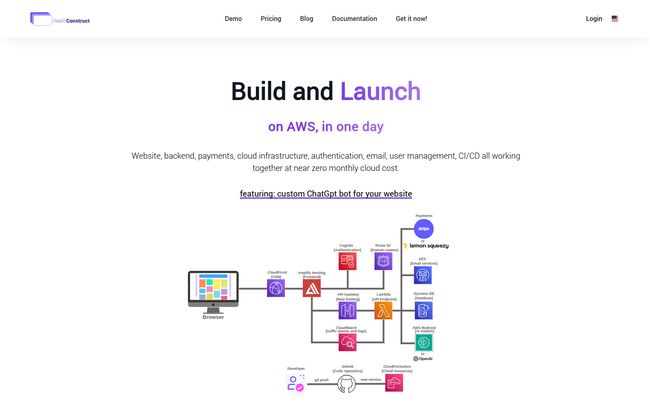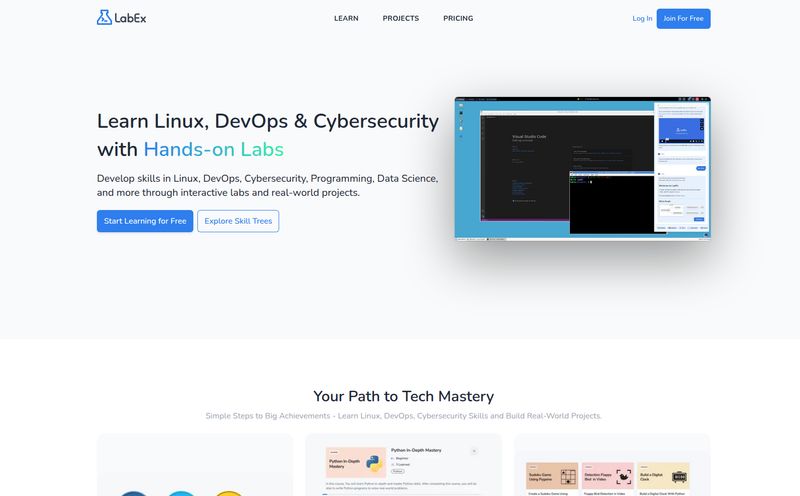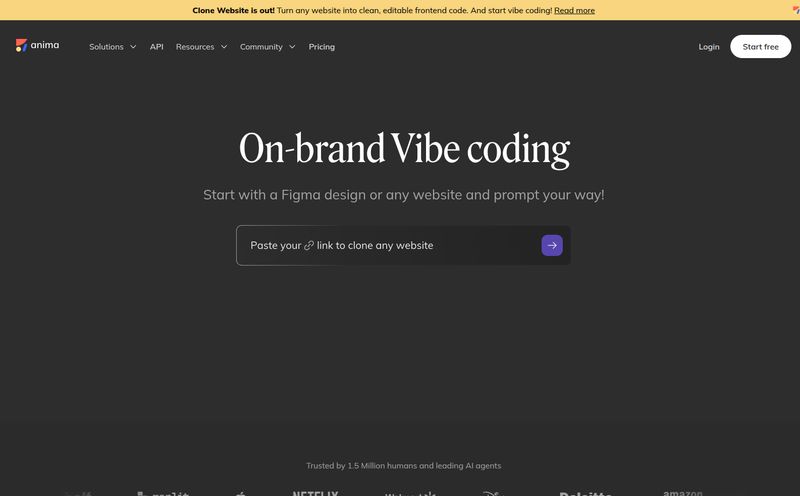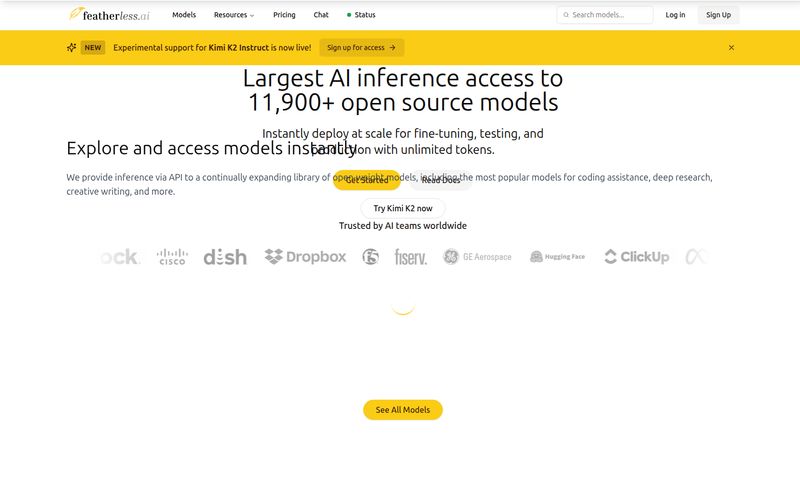Let’s have a little heart-to-heart. You’ve got a brilliant idea for a SaaS product. You can see it clear as day: the UI, the killer feature, the problem it solves. You’re ready to build. But then reality hits. Before you can even write a single line of code for your actual idea, you have to build the house it's going to live in. We're talking authentication, user management, subscription billing, setting up a database, wiring up a CI/CD pipeline... it's a mountain of work. And honestly, it's the same mountain every single time.
I’ve been there more times than I care to admit. Spending weeks, not days, just getting the boilerplate plumbing in place. It's a soul-crushing part of the process that kills momentum before you even get started. So, when I stumbled across something called SaaS Construct, which promised to get a full-stack SaaS application up and running on AWS in one day, my battle-hardened cynicism immediately kicked in. But so did my curiosity.
Is this just another boilerplate that promises the world and delivers a half-baked template? Or is it the real deal? I had to find out.

Visit SaaS Construct
So, What is SaaS Construct Anyway?
At its core, SaaS Construct is a pre-built foundation—a SaaS boilerplate, if you will—designed specifically for the AWS ecosystem. Think of it like a high-quality, prefab home kit for your software idea. Instead of chopping down the trees and milling the lumber yourself (a.k.a. coding auth from scratch), you get all the pre-cut, perfectly measured pieces ready for assembly. This includes the website, the backend logic, payment processing, cloud infrastructure, and even a CI/CD pipeline. All working together from the get-go.
But the part that really caught my eye was its modern twist. It's built on a serverless architecture and comes “AI-ready” with a custom, ChatGPT-like bot you can train on your own data. In a world where every other app is scrambling to add AI features, starting with one out of the box is a pretty compelling advantage.
The Core Features That Actually Matter
A feature list is just a list. What matters is how those features solve real, hair-pulling-out problems for developers. Let's break down what SaaS Construct brings to the table.
Your Foundation on AWS Serverless
This is the bedrock of the whole system. SaaS Construct uses AWS Lambda for the backend (written in Python) and AWS CDK for defining the infrastructure as code. For those of us who've been burned by surprise five-figure AWS bills, the word “serverless” is music to our ears. It means your costs are near-zero when nobody's using your app, especially during development. You're not paying for idle servers. It scales automatically, and you only pay for what you use. This is a massive win for indie hackers and bootstrapped startups watching every penny.
User Authentication and Payments, Solved
If you've ever tried to integrate AWS Cognito, you know it's... an experience. Powerful, yes, but not exactly intuitive. SaaS Construct comes with it pre-configured for email/password and Google OAuth. Done. Dusted. Move on.
Then there's payments. It offers integrations for both Stripe and LemonSqueezy, handling subscriptions, checkouts, and even a customer portal for users to manage their own billing. The amount of time this saves is just staggering. It’s not just the integration, it’s the webhooks, the edge cases, the invoicing logic. It's all there.
The "AI-Ready" Promise: More Than a Buzzword?
Okay, I was skeptical about this one. “AI-Ready” gets thrown around a lot. But here, it seems to have some real substance. The boilerplate includes a functioning AI chatbot that you can feed your own documentation or data. It leverages big-name AI models through AWS Bedrock or OpenAI directly. Imagine having a customer support bot or an intelligent in-app assistant that actually knows your product from day one. That's not a gimmick; that’s a powerful feature that can improve user experience and reduce support load right away.
A Developer-Friendly Workflow
The whole process is boiled down to two simple steps: `git clone` to get the code, and `git push` to deploy. A push to your GitHub repository automatically triggers the CI/CD pipeline, which builds and releases a new version of your application. No wrestling with YAML files for days on end. This is how development should feel. Fast, iterative, and focused on building features, not fighting with deployment scripts.
Let's Look at the Price Tag
Alright, this is the moment of truth. How much does this magic box cost? The pricing is surprisingly straightforward, which I appreciate. No confusing recurring fees, just a one-time payment.
| Plan | Price | Key Feature |
|---|---|---|
| Starter | $99 (one-time) | All features included, with 1 year of updates. |
| All-in | $129 (one-time) | All features included, with 2 years of updates. |
Honestly, the value proposition here is pretty wild. For an extra $30, you get a whole additional year of updates. In the fast-moving world of cloud and AI, that seems like a no-brainer to me. Considering what a developer's time is worth, you'd spend far more than $129 in just a few hours trying to build even a fraction of this yourself.
The Good, The Bad, and The AWS-y
No tool is perfect. Let's get into the nitty-gritty. This is where you decide if it's a fit for you.
What I Love (The Pros)
The biggest pro is speed. You're buying back weeks, maybe even months, of your life. The comprehensive nature of the features is also a huge plus. It’s not just auth; its auth, payments, a blog engine, a documentation engine, API endpoints with rate limiting, and so on. The serverless, pay-as-you-go cost model during development is a godsend for anyone on a budget. And the baked-in AI chatbot is a genuine differentiator.
Potential Gotchas (The Cons)
Okay, let's be real for a second. This isn't for a complete beginner who's never touched a cloud platform. The website says it's for AWS, and it means it. You're going to need a foundational familiarity with AWS services like Lambda, CDK, and Cognito to really customize and troubleshoot things. If you dont know your IAM roles from your S3 buckets, you might have a steep learning curve.
There's also the question of vendor lock-in. You're buying into the SaaS Construct way of doing things. While it's built on standard AWS components, the specific glue holding it all together is theirs. This is a common trade-off with any boilerplate, but one to be aware of. Lastly, the updates are tied to your purchase plan. After your 1 or 2 years are up, you won't get new features or security patches unless you buy again. It’s a fair model, but something to plan for.
So Who is This Really For?
I see this being a perfect fit for a few groups: the solo indie hacker who wants to validate an idea fast, a small development team that needs to build an MVP without getting bogged down in infra, or the experienced freelancer looking to spin up new projects for clients efficiently.
If you're comfortable in the AWS playground and your main goal is to get a product to market yesterday, SaaS Construct could be your new best friend. If you're looking to learn cloud development from scratch or need a solution on a different cloud provider, this obviously isn't it.
Frequently Asked Questions
What exactly is SaaS Construct?
It's a comprehensive SaaS boilerplate built for the AWS Cloud. It provides pre-written code and pre-configured infrastructure for common features like authentication, payments, user management, and even an AI chatbot, allowing you to launch a product much faster.
How much does SaaS Construct cost?
It’s a one-time purchase. The Starter plan is $99 for 1 year of updates, and the All-in plan is $129 for 2 years of updates. Your cloud costs on AWS are separate but are designed to be very low, especially during development, due to the serverless architecture.
What is the tech stack used?
The frontend is Vue.js (using Typescript), the backend is Python running on AWS Lambda, and the infrastructure is managed with the AWS Cloud Development Kit (CDK).
Is it hard to use if I don't know AWS well?
It's best suited for developers who have some familiarity with AWS. While it simplifies many complex processes, you'll still be working within the AWS ecosystem, so a basic understanding of services like Lambda and CDK is highly beneficial for customization and long-term management.
What happens when my included updates expire?
Your project will continue to work perfectly fine, but you will no longer receive new features, bug fixes, or security patches from the SaaS Construct team. You would need to purchase a new license to get access to the latest version and updates.
My Final Verdict
After digging in, I'm genuinely impressed. SaaS Construct isn't just another template; it's a well-thought-out development accelerator. It understands the most painful, time-consuming parts of building a new SaaS product and just... handles them. For the right developer, the one-time cost is an absolute steal when you measure it against the time and frustration it saves.
It won't build your business for you, but it lays down an incredibly solid and modern foundation so you can focus on what truly matters: building the unique features that will make your customers fall in love with your product. And in this game, that head start is everything.



